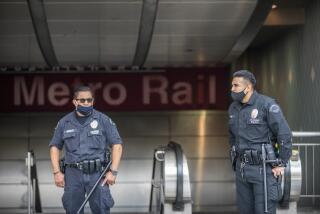‘Braking the RTD Monopoly
- Share via
In the article (Editorial Pages, Nov. 2), “Braking the RTD Monopoly,” Pete Schabarum, chairman of the Los Angeles County Board of Supervisors, made some sweeping statements about RTD that cannot go unchallenged.
Twenty-two years ago, the Rapid Transit District was formed to unify a confusing maze of overlapping transit services in the Southland. As it exists today, the RTD offers a cohesive, regional public transit service capable of taking a rider to almost any point in the Greater Los Angeles area for one base fare. The district has very high safety standards, carries more than 1.5 million passengers each day, and provides special service to its disabled riders. The RTD is accountable to the public when changes are proposed.
Privatization, the use of private agencies to improve regional service, can work. In fact, the RTD’s goal, as set out in its Five-Year Short Range Transit Plan, is to have 2.5% of all service contracted to private operators by 1991. But important questions need to be answered first. If they aren’t, privatization can result in a massive public headache, rider confusion, and possibly greater total costs than the present system.
Before leaping blindly into privatization, the question should be asked: Is it worth punching holes in an already cohesive regional system of bus routes just in the interest of cost-cutting?
Or in addition, should we be talking about adding service to meet a 3%, or 10-million rider, increase each year? Will using a private agency improve service in the region it serves, or would it simply duplicate RTD’s lines, thus duplicating costs?
Will RTD buses have to travel uselessly through a “privatized” zone to pick up where the other service ends? Can a private agency provide the public the same range of services now offered by the RTD?
If slicing into RTD’s system means reducing the quality and quantity of regional service as a whole, the RTD is opposed to it. But in the cases where privatization can work--as it has with agencies in Paramount and Antelope Valley, for instance--the RTD not only supports it, but encourages it.
Schabarum says there were savings of between 10% and 50% in transit districts where the private sector is used. Those statistics need some clarifying: the vast majority of those agencies that performed well financially did not have labor unions, as we do at the RTD. And, though a private agency may begin with lower wages for its operators, as time passes it is likely that they will organize and push salary levels much higher, as has been the case in other cities.
As to the RTD’s performance, Schabarum didn’t mention that the Price-Waterhouse audit gave the district extremely high marks in 15 or 16 major categories. In the one category of absenteeism, the RTD did no worse--but no better--in the 1983-85 period than it did in earlier years. This record of major improvements was accomplished during the period of the 50-cent fare, which resulted in a dramatic ridership increase of 600,000 people a day. Moreover, on the whole the auditors found that the RTD was performing better transit over the same three-year period than other transit agencies they analyzed.
We agree with Schabarum on one count: The bus-riding public deserves the finest service available. He and the public at large can be sure that the RTD will continue its commitment to provide the best transportation service with the highest possible efficiency.
JAN HALL
Los Angeles
Hall is director and president of the Southern California Rapid Transit District.
More to Read
Sign up for Essential California
The most important California stories and recommendations in your inbox every morning.
You may occasionally receive promotional content from the Los Angeles Times.













